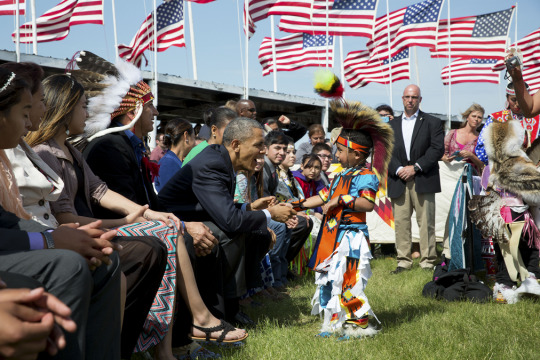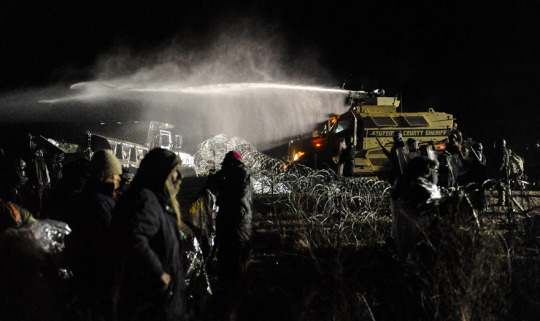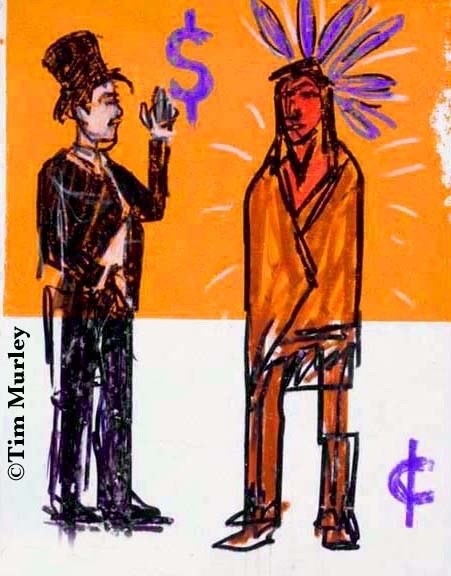#standing rock sioux
Text
Gov. Kristi Noem, a Trump lickspittle, is banned from 15% of her state of South Dakota. She is one of the contestants for the number two position on Trump's national ticket.
As South Dakota governor Kristi Noem vies for a top position in a second Trump White House, she appears to be more focused on shoring up her vice-presidential chances than on making allies at home — to the point that she is no longer welcome in around 15 percent of the state she governs.
Over the past few months, Noem has made several comments about alleged drug trafficking on Native American reservation lands, infuriating a number tribes in the state. In February, the Oglala Sioux Tribe banned her from the Pine Ridge Indian Reservation, the fifth largest in the United States, for claiming without evidence that drug cartels were connected to murders on the reservation.
The ban did not dissuade her from making more incendiary remarks. In March, Noem said at a community forum in Winner that there are “some tribal leaders that I believe are personally benefiting from cartels being there and that’s why they attack me every day.” When tribal leaders demanded an apology, Noem doubled down, issuing a statement to the tribes to “banish the cartels.” In response, the Cheyenne River Sioux forbade Noem from setting foot on their reservation, the fourth largest in the U.S. On Wednesday, the Standing Rock Sioux Tribe, the sixth largest in the U.S., banned her as well. On Thursday, a fourth tribe, the Rosebud Sioux, followed suit.
So far, four tribes are banning Noem:
Oglala Sioux
Rosebud Sioux
Cheyenne River Sioux
Standing Rock Sioux
Alleged drug cartels on tribal lands in South Dakota are the local equivalent of millions of migrants illegally voting in 2020. Bullshit is not just a GOP specialty but a dedicated lifestyle.
#south dakota#kristi noem#drug cartels#bullshit#tribal lands#native americans#noem banned on tribal lands#oglala sioux#standing rock sioux#rosebud sioux#cheyenne river sioux#donald trump#trump running mate#election 2024#vote blue no matter who
13 notes
·
View notes
Photo





Native American/First Nations Woman Writer of the Week
SUSAN POWER
March may have come to an end, but there is still time to celebrate! The next Indigenous writer I would like to give the spotlight to is Susan Power (1961-), a Native American novelist who is an enrolled member of the Standing Rock Sioux Tribe of the Dakotas. She was born in Chicago, Illinois and raised by her mother, Susan Kelly Power (Gathering of Stormclouds Woman, in Dakota) who is also an enrolled member, and her father Carleton Gilmore Power, who was a publishing sales representative. Her parents raised her to be politically and socially aware, and with their help became active in the Civil Rights movement. She was named Miss Indian Chicago when she was seventeen and after that went on to get an A.B. degree in Psychology at Harvard/Radcliffe, and later received her Juris Doctorate from Harvard Law School. She worked her way up from a housekeeping job to being the editor of the University of Chicago Law Review, which was the catalyst for motivating her to pursue creative writing. Her mother used to recite stories about their native lineage, and her father read her stories at night; she states that her inspiration come from her mother’s native influence as well as Louise Erdrich, Toni Morrison, and Shakespeare. By the age of twelve she had memorized the entirety of Romeo and Juliet.
Power ultimately decided to end her law career and pursue creative writing fully while she was recovering from an appendectomy. The catalyst for this choice was a Dakota Sioux woman standing in her hospital room wearing a sky blue beaded dress; this vision spirit would later become a main character of her first novel The Grass Dancer, which was published by Putnam in 1994. This novel went on to win the PEN/Hemingway Award for First Novel in 1995. Her short fiction has also been published in Atlantic Monthly, Paris Review, Voice Literary Supplement, Ploughshares, Story, and The Best American Short Stories 1993.
Power focuses heavily on themes of ancestry, dream images, and intricate storytelling to fully engage her readers. She uses the strengths of these themes to relate her personal experience as a Native American woman while leaving room for the reader to interpret and respond to her writing in their own way without limiting the possibilities.
UWM Special Collection preserves Power’s Sacred Wilderness (Michigan State University Press, 2014) and Roofwalker (Milkweed Editions, 2002).
View more posts on Native American/First Nations Women Writers.
- Elizabeth V., Special Collections Undergraduate Writing Intern
#Native American/First Nations Woman Writer of the Week#Women's History Month#Native Americans#native american writers#native american women writers#Susan Power#Dakota#Yanktonai Dakota#Standing Rock Sioux#Sacred Wilderness#Roofwalker#Elizabeth V.
31 notes
·
View notes
Text

Standing rock SOS. 🆘⛺️🪶
#standing rock sioux#standing rock#north dakota#lakota sioux#lakota#sioux#sioux nation#powwow#pow wow#dream catcher#petroglyphs#first nation#first nations#teepee#tomahawk#redskins#indigenous rights#indigenous pride#indigenous people#indigenous peoples day#indigenous#american indian#sitting bull#crazy horse#apache#iroquois#naive art#art brut#jean michel basquiat#basquiat
19 notes
·
View notes
Text
#talkin#tik tok#white supremacy#lakota#native americans#indigenous americans#cultural appropriation#standing rock sioux tribe
5K notes
·
View notes
Text
Native Tribe To Get Back Land 160 Years After Largest Mass Hanging In US History
Upper Sioux Agency state park in Minnesota, where bodies of those killed after US-Dakota war are buried, to be transferred
— Associated Press | Sunday 3 September, 2023

The Upper Sioux Agency State Park near Granite Falls, Minnesota. Photograph: Trisha Ahmed/AP
Golden prairies and winding rivers of a Minnesota state park also hold the secret burial sites of Dakota people who died as the United States failed to fulfill treaties with Native Americans more than a century ago. Now their descendants are getting the land back.
The state is taking the rare step of transferring the park with a fraught history back to a Dakota tribe, trying to make amends for events that led to a war and the largest mass hanging in US history.
“It’s a place of holocaust. Our people starved to death there,” said Kevin Jensvold, chairman of the Upper Sioux Community, a small tribe with about 550 members just outside the park.
The Upper Sioux Agency state park in south-western Minnesota spans a little more than 2 sq miles (about 5 sq km) and includes the ruins of a federal complex where officers withheld supplies from Dakota people, leading to starvation and deaths.
Decades of tension exploded into the US-Dakota war of 1862 between settler-colonists and a faction of Dakota people, according to the Minnesota Historical Society. After the US won the war, the government hanged more people than in any other execution in the nation. A memorial honors the 38 Dakota men killed in Mankato, 110 miles (177km) from the park.
Jensvold said he has spent 18 years asking the state to return the park to his tribe. He began when a tribal elder told him it was unjust Dakota people at the time needed to pay a state fee for each visit to the graves of their ancestors there.

Native American tribe in Maine buys back Island taken 160 years ago! The Passamaquoddy’s purchase of Pine Island for $355,000 is the latest in a series of successful ‘land back’ campaigns for indigenous people in the US. Pine Island. Photograph: Courtesy the writer, Alice Hutton. Friday 4 June, 2021
Lawmakers finally authorized the transfer this year when Democrats took control of the house, senate and governor’s office for the first time in nearly a decade, said State Senator Mary Kunesh, a Democrat and descendant of the Standing Rock Nation.
Tribes speaking out about injustices have helped more people understand how lands were taken and treaties were often not upheld, Kunesh said, adding that people seem more interested now in “doing the right thing and getting lands back to tribes”.
But the transfer also would mean fewer tourists and less money for the nearby town of Granite Falls, said Mayor Dave Smiglewski. He and other opponents say recreational land and historic sites should be publicly owned, not given to a few people, though lawmakers set aside funding for the state to buy land to replace losses in the transfer.
The park is dotted with hiking trails, campsites, picnic tables, fishing access, snowmobiling and horseback riding routes and tall grasses with wildflowers that dance in hot summer winds.
“People that want to make things right with history’s injustices are compelled often to support action like this without thinking about other ramifications,” Smiglewski said. “A number, if not a majority, of state parks have similar sacred meaning to Indigenous tribes. So where would it stop?”
In recent years, some tribes in the US, Canada and Australia have gotten their rights to ancestral lands restored with the growth of the Land Back movement, which seeks to return lands to Indigenous people.

‘It’s a powerful feeling’: the Indigenous American tribe helping to bring back buffalo 🦬! Matt Krupnick in Wolakota Buffalo Range, South Dakota. Sunday 20 February, 2022. The Wolakota Buffalo Range in South Dakota has swelled to 750 bison with a goal of reaching 1,200. Photograph: Matt Krupnick
A National Park has never been transferred from the US government to a tribal nation, but a handful are Co-managed with Tribes, including Grand Portage National Nonument in northern Minnesota, Canyon de Chelly National Monument in Arizona and Glacier Bay National Park in Alaska, Jenny Anzelmo-Sarles of the National Park Service said.
This will be the first time Minnesota transfers a state park to a Native American community, said Ann Pierce, director of Minnesota State Parks and trails at the natural resources department.
Minnesota’s transfer, expected to take years to finish, is tucked into several large bills covering several issues. The bills allocate more than $6m to facilitate the transfer by 2033. The money can be used to buy land with recreational opportunities and pay for appraisals, road and bridge demolition and other engineering.
Chris Swedzinski and Gary Dahms, the Republican lawmakers representing the portion of the state encompassing the park, declined through their aides to comment about their stances on the transfer.
— The Guardian USA
#Minnesota#U.S. 🇺🇸 News#World 🌎 News#Native Tribes#Land Buy Back#The Upper Sioux Agency State Park#Burial Sites of Dakota People#United States 🇺🇸 | Failed Treaties#Native Americans#Kevin Jensvold | Upper Sioux Community#US-Dakota War of 1862#Dakota Men Killed | Mankato#Minnesota Historical Society#State Senator | Mary Kunesh | Democrat | Descendant | Standing Rock Nation#Granite Falls#Mayor Dave Smiglewski#US 🇺🇸 | Canada 🍁 🇨🇦 | Australia 🇦🇺#Ancestral Lands Restored#Land Back Movements#Grand Portage National Nonument#Canyon de Chelly National Monument#Glacier Bay National Park#Ann Pierce | Minnesota State Parks#Chris Swedzinski | Gary Dahms | Republican Lawmakers
259 notes
·
View notes
Text
By JON QUEALLY
Common Dreams
Sep 09, 2023
"The Corps' covering for the pipeline company's outrageous safety record and the reviewer's serious conflict of interest have now resulted in a failed effort," said Standing Rock Sioux Tribe Chairwoman Janet Alkire. "They need to start over with adult supervision."
Standing Rock Sioux Tribe Chairwoman Janet Alkire is leading a fresh demand that the U.S. Army Corps of Engineers throw out an ongoing environmental review process of the controversial Dakota Access Pipeline and start again from scratch alongside a superseding call for the pipeline to be shuttered completely.
Following Friday's release of a revised Environmental Impact Statement (EIS), ordered by a federal court, the tribe said the document reveals the entire process has been a failure and that the pipeline—currently operating across their land without consent in what they consider an "illegal" manner by the Energy Transfer company—should be shut down once and for all.
"We're furious that the Army Corps has addressed none of our major concerns during the review process," Chairwoman Alkire said in a statement.
"The pipeline is an imminent threat to the Missouri River, sensitive habitat, and sacred burial sites along the riverbank," she continued. "The oil company's emergency response plans are inadequate, its safety track record is horrendous, and there's been a stunning lack of transparency with Standing Rock throughout the environmental review process, including inaccurate characterizations of tribal consultation."
The Army Corps did not make any recommendations or indicate preferences among the alternatives presented in the new EIS report, which included keeping it in operation, possible rerouting, removing the pipeline by excavation, or abandoning it in place. The Corps said its final recommendations will accompany a final report once the review process is complete, but the Standing Rock Sioux said the process has been seriously flawed.
The tribe said the draft EIS fails to "account for the existence of criminal charges and a host of fines and serious citations" from regulators faced by Energy Transfer. Alkire accused the Corps of "doing all it can to ignore the company’s poor safety record and the high risk" of the pipeline. According to the statement by the tribe:
the entirety of the environmental review process hasn't been taken seriously and is compromised because the Corps selected a company with a clear conflict of interest to prepare the just-released draft EIS. Environmental Resources Management — which also produced a sparkling environmental review for the Keystone XL pipeline, later shelved due to environmental concerns — is a member of the American Petroleum Institute. That organization previously filed a legal brief in support of DAPL in Standing Rock’s suit against the Army Corps.
Moreover, Environmental Resources Management has contracted with at least five separate companies with an ownership interest in DAPL.
The release of the EIS triggers a 45-day public comment period and the Standing Rock Sioux Tribe is now requesting public support in opposition of the project.
"The Corps' covering for the pipeline company's outrageous safety record and the reviewer's serious conflict of interest have now resulted in a failed effort," said Alkire of the current process. "They need to start over with adult supervision."
Amy Mall, senior advocate at NRDC, said her group stands "in solidarity with the Standing Rock Sioux Tribe in opposing this dirty and dangerous pipeline that harms the climate and threatens the primary water source for the Tribe."
"The Army Corps must consider all of the risks of this pipeline, make all significant environmental information available without redactions, and honor the Tribe’s treaty rights," Mall added. "We call on the Corps to shut it down."
Our work is licensed under Creative Commons (CC BY-NC-ND 3.0). Feel free to republish and share widely.
JON QUEALLY
Jon Queally is managing editor of Common Dreams.
Full Bio >
#standing rock sioux tribe#dakota access pipeline#u.s. army corps of engineers#fossil fuels#climate crisis#climate change#NRDC
116 notes
·
View notes
Text
#indigenous#native american#good news#solar power#standing rock#standing rock sioux tribe#lakota#indigenized energy#green energy#renewable energy#solar energy
43 notes
·
View notes
Photo

Dress
Húŋkpapȟa (Hunkpapa) Lakota of Cannon Ball, Standing Rock Reservation
c.1910
National Museum of the American Indian (Catalog Number: 23/2977)
Learn more about the Standing Rock Lakota People at their website: https://www.standingrock.org/
#dress#fashion history#sioux#standing rock#indigenous fashion#non western fashion#lakota#hunkpapa lakota#1910s#20th century#native american#indigenous american#wool#shells#traditional fashion#traditional clothing#national museum of the american indian
474 notes
·
View notes
Photo

Happy Flag Day!
President Obama visits the Standing Rock Sioux Tribe’s Cannon Ball Powwow on Flag Day, 2013.
Series: Presidential Photographs, 1/20/2009 - 1/20/2017
Collection: Records of the White House Photo Office (Obama Administration), 1/20/2009 - 1/20/2017
Image description: President Obama, seated, shakes hands with a boy wearing orange, turquoise, and white powwow regalia including ankle bells and a roach style headdress. All around are other powwow attendees wearing Western clothing or powwow regalia. In the background are numerous American flags flying in the wind.
#archivesgov#Flag Day#2013#2010#Obama administration#Standing Rock Sioux Tribe#Lakota#Dakota#powwow#regalia
70 notes
·
View notes
Text

Chickens, ca. 1930-1949
Standing Rock Sioux Tribe of North & South Dakota
Record Group 75: Records of the Bureau of Indian Affairs
Series: Photographs
National Archives Catalog
#chickens#sioux#national archives#bureau of indian affairs#standing rock sioux tribe of north & south dakota
4 notes
·
View notes
Text
hey!!!! remember standing rock water protectors and the dakota access pipeline?
the massive, poorly constructed environmental risk that spat all over the Standing Rock Sioux people's treaty rights? that dug up their sacred burial sites? the one where the oil corporation who owned it bought out a private company to do a sham of an "environmental analysis" and never consulted the tribe and STILL didn't actually get approval? the one that's literally operating illegally and without proper permits right fucking now?




yeah, that.
you remember that.
surprising absolutely no one, the army corps of engineers this week (September 8, 2023) released an EIS (environmental impact statement) draft for public comment that takes into account absolutely 0 of the tribe's concerns, and in fact did not consult with them once in the process!
they're going to officially approve the pipeline.
what's the good news?
IT'S A DRAFT. YOU CAN SUBMIT PUBLIC COMMENT RIGHT NOW UNTIL NOVEMBER 13!!!
This link RIGHT HERE (https://action.lakotalaw.org/action/dapl-eis-2023) will take you to a Lakota Law Project page where they've set up a form to make it easy to submit a comment.
All you have to do is add your name, email, and zip code, and it pulls up a form with a pre-written message you can just click and submit, listing the most pressing concerns. You can also personalize it if you want, but you don't have to. This will take you two minutes. Please.
you can also access the comment information on the USACE website here, email [email protected] yourself, or call Brent Cossette, the contact for the draft, at 402-995-2716!!!
you can also donate directly to the Standing Rock Sioux Tribe here.
#signal boost#no dapl#anti indigenous violence#idk how to tag stuff just wanted to try#you know#this is important#idk
26K notes
·
View notes
Text
State of Minnesota Transferring State Park to Dakota Tribe
The State of Minnesota is now engaged in transferring the Upper Sioux Agency State Park in the southwestern part of the State to a Dakota Indian Tribe that was involved in its tragic history.[1]
Historical Background
The Treaty of Traverse Des Sioux of 1851 moved the Dakota Indians from Iowa and Minnesota to a reservation 20 miles wide in southwestern Minnesota along the Minnesota River Valley.…
View On WordPress
#Dakota Indian Tribe#Kevin Jensvold#Mary Kunesh#Minnesota#Standing Rock Nation#Treaty of Traverse Des Sioux of 1851#U.S.-Dakota War of 1862#Upper Sioux Agency State Park#Yellow Medicine Agency
1 note
·
View note
Text

The land deal. 🆘⛺️🪶
#real estate#first nation#first nations#crazy horse#sitting bull#Iroquois#Apache#standing rock sioux#sioux#sioux nation#north dakota#standing rock#american indian#native american#indigenous rights#indigenous pride#indigenous people#indigenous peoples day#neo pop art#monoprint#silkscreenprinting#silkscreen#hand lettering#poster art#basquiat#jean michel basquiat#contemporary art#chippewa#algonquin#lakota sioux
7 notes
·
View notes
Text
"Cody Two Bears, a member of the Sioux tribe in North Dakota, founded Indigenized Energy, a native-led energy company with a unique mission — installing solar farms for tribal nations in the United States.
This initiative arises from the historical reliance of Native Americans on the U.S. government for power, a paradigm that is gradually shifting.
The spark for Two Bears' vision ignited during the Standing Rock protests in 2016, where he witnessed the arrest of a fellow protester during efforts to prevent the construction of the Dakota Access Pipeline on sacred tribal land.
Disturbed by the status quo, Two Bears decided to channel his activism into action and create tangible change.
His company, Indigenized Energy, addresses a critical issue faced by many reservations: poverty and lack of access to basic power.
Reservations are among the poorest communities in the country, and in some, like the Navajo Nation, many homes lack electricity.
Even in regions where the land has been exploited for coal and uranium, residents face obstacles to accessing power.
Renewable energy, specifically solar power, is a beacon of hope for tribes seeking to overcome these challenges.
Not only does it present an environmentally sustainable option, but it has become the most cost-effective form of energy globally, thanks in part to incentives like the Inflation Reduction Act of 2022.
Tribal nations can receive tax subsidies of up to 30% for solar and wind farms, along with grants for electrification, climate resiliency, and energy generation.
And Indigenized Energy is not focused solely on installing solar farms — it also emphasizes community empowerment through education and skill development.
In collaboration with organizations like Red Cloud Renewable, efforts are underway to train Indigenous tribal members for jobs in the renewable energy sector.
The program provides free training to individuals, with a focus on solar installation skills.
Graduates, ranging from late teens to late 50s, receive pre-apprenticeship certification, and the organization is planning to launch additional programs to support graduates with career services such as resume building and interview coaching...
The adoption of solar power by Native communities signifies progress toward sustainable development, cultural preservation, and economic self-determination, contributing to a more equitable and environmentally conscious future.
These initiatives are part of a broader movement toward "energy sovereignty," wherein tribes strive to have control over their own power sources.
This movement represents not only an economic opportunity and a source of jobs for these communities but also a means of reclaiming control over their land and resources, signifying a departure from historical exploitation and an embrace of sustainable practices deeply rooted in Indigenous cultures."
-via Good Good Good, December 10, 2023
#indigenous#native americans#first nations#indigenous rights#tribal sovereignty#solar energy#solar power#solar panels#renewable energy#green energy#sioux#sioux nation#sustainability#climate hope#electrification#united states#hope#good news
2K notes
·
View notes
Text
Up to 10 informants managed by the FBI were embedded in anti-pipeline resistance camps near the Standing Rock Sioux Indian Reservation at the height of mass protests against the Dakota Access pipeline in 2016. The new details about federal law enforcement surveillance of an Indigenous environmental movement were released as part of a legal fight between North Dakota and the federal government over who should pay for policing the pipeline fight. Until now, the existence of only one other federal informant in the camps had been confirmed.
The FBI also regularly sent agents wearing civilian clothing into the camps, one former agent told Grist in an interview. Meanwhile, the Bureau of Indian Affairs, or BIA, operated undercover narcotics officers out of the reservation’s Prairie Knights Casino, where many pipeline opponents rented rooms, according to one of the depositions.
The operations were part of a wider surveillance strategy that included drones, social media monitoring, and radio eavesdropping by an array of state, local, and federal agencies, according to attorneys’ interviews with law enforcement.
573 notes
·
View notes
Photo

Sitting Bull
Sitting Bull (Tatanka Iyotanka, l. c. 1837-1890) was a Hunkpapa Sioux holy man, warrior, leader, and symbol of traditional Sioux values and resistance to the United States' expansionist policies. He is among the best-known Native American chiefs of the 19th century and remains as famous today as he was when he led his people.
He is widely known for his part in the Battle of the Little Bighorn in June 1876 and his later celebrity as a performer in Buffalo Bill's Wild West Show, but, for the Sioux, Sitting Bull is celebrated as the embodiment of the four cardinal virtues of his people: courage, fortitude, generosity, and wisdom. He is also recognized for his refusal to abandon the traditions of his people and his efforts to preserve their culture. Although famous as a holy man, prophet, war chief, and hunter, Sitting Bull was also a poet and composer, as well-known among his people for his rapport with wild animals and herbal knowledge as for his leadership.
He was killed while resisting arrest at the Standing Rock Agency Reservation in South Dakota on 15 December 1890 and was buried at Fort Yates in North Dakota. His remains were exhumed by family members in the 1950s and interred at Mobridge, South Dakota, near where he was thought to have been born. Debate continues over whether these remains are those of Sitting Bull, and historians also offer differing views on his legacy. His reputation as a great leader of his people, however, is unchallenged as he continues to be recognized as a symbol of Native American pride, honor, and traditional values, as well as for his stand against injustice.
Youth & Name
Little is known of Sitting Bull's life before the age of 14. His date of birth, given as 1831, 1832, 1834, or 1837, is debated, as was his birthplace until fairly recently. He is now understood to have been born on the Yellowstone River (known to the Sioux as Elk River) in modern-day Montana and was named Jumping Badger (Hoka Psice). He quickly earned the nickname Slow (Hunkesni), owing, according to scholar Robert. M. Utley, to "his willful and deliberate ways" (6). His father was Chief Sitting Bull of the Hunkpapa Sioux, and his mother was Her-Holy-Door from a respectable Hunkpapa family. He had two sisters and a half-brother but would later adopt others as his brothers, and these are sometimes mistakenly referenced as biological siblings.
Chief Sitting Bull taught his son to ride, hunt, and shoot expertly before the boy was ten years old. Young Slow was an excellent shot with bow and arrow and became so closely associated with horses that his peers joked how he even walked as though he were on horseback. When he was 14, he joined a war party against the Crow and "counted coup" against a Crow warrior, knocking him from his horse where he was then killed by another of the party. For this act of courage – defeating an enemy without killing him – Chief Sitting Bull gave his name to his son and assumed the name Jumping Bull. "Sitting Bull" – Tatanka Iyotanka (literally "Buffalo Who Sits Down") – fit the youth's personality as, "according to fellow tribesmen, suggested an animal possessed of great endurance, his build much admired by the people, and when brought to bay, planted immovably on his haunches to fight on to the death" (Utley, 15).
Later acquaintances and writers would claim the name was given him due to his stubbornness or, according to Sioux writer and physician Charles A. Eastman, that he was given the name after forcing a buffalo calf to sit down. The name was actually given in accordance with the tradition whereby a father passed his own name to his son when the boy was recognized as attaining manhood.
Between the ages of 14 and 20, Sitting Bull led his own war parties, and his name became famous among his enemies as a formidable warrior. Utley describes him at around the age of 20:
A heavy, muscular frame, a big chest, and a large head, he impressed people as short and stocky, although he stood only two inches under six feet. His dark hair, often braided on one side with otter fur and allowed to hang loose on the other, reached his shoulders. A severe part over the center of the scalp glistened with a heavy streak of crimson paint. A low forehead surmounted piercing eyes, a flat nose, and thin lips. Although dexterous afoot and superbly agile mounted, he appeared to some as awkward and even clumsy. (19-20)
Around 1857, in a clash with an Assiniboine band, Sitting Bull spared a 13-year-old boy whom he later adopted as a younger brother. When Sitting Bull's father was killed in battle with the Crow in 1859, the boy took the name Jumping Bull and would remain by Sitting Bull's side for the rest of his life.
Continue reading...
110 notes
·
View notes